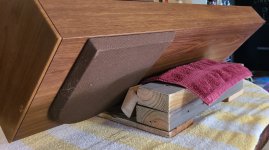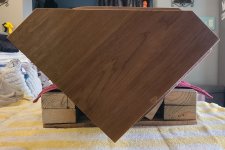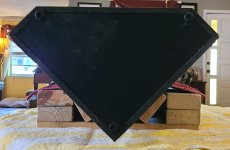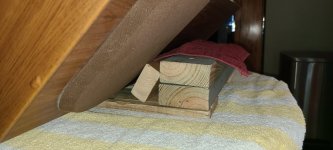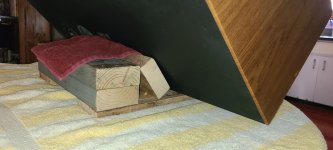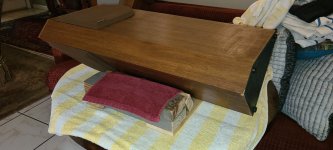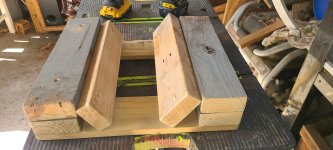Electrical aside, to me it adds a little more midrange to the front woofer, takes away from the tweeter but gives further protection at the same time.
I need the smart guys to answer this one. Just a curious George here.
I need the smart guys to answer this one. Just a curious George here.
Again, I highly doubt the cap is bad.
I wouldn't change the wiring, Bose doesn't just do things unnecessarily.
If you're not setting out to reinvent the speaker, leave as is.
I wouldn't change the wiring, Bose doesn't just do things unnecessarily.
If you're not setting out to reinvent the speaker, leave as is.
Again, I highly doubt the cap is bad.
Quite possibly the capacitor is not bad, but the possibility that it is should be eliminated.
To quote the problem, "the highs are muddled. Those from the left tweeter almost sound as if the tweeter is blown".
That prompts me to restate your information that, "A bad protection lamp can make a scratchy sound in the tweeter as the woofers vibrate it".
And that is why I have asked the OP to "inspect both speakers to check the condition of the lamps".
I wouldn't change the wiring, Bose doesn't just do things unnecessarily.
If that refers to the mystery grey wire, I wholeheartedly agree!
And if the grey wire in question is going to remain a mystery: SpineyNorman can you let us know if the front woofer actually has 3 terminals on it? The way the schematic is drawn leads me to believe that's the case, but I'm speculating.
And I'm even more confused since the terminal block picture has a yellow and grey wire tied together on one side.
And I'm even more confused since the terminal block picture has a yellow and grey wire tied together on one side.
Read post #3. Resistors do not age. Only if the speaker was driven with excessive watts. Electrolytic caps do, they are water filled bottles sealed with rubber. Rubber cracks with age, unless the cap was epoxy sealed. Fender was famous for using epoxy sealed electrolytic caps. Bose is not. The chart post # 25 clearly says the 4.5 uf cap is electrolytic.Do you guys have suggestions of places where I can source those caps, resistors and lamps?
Factory techs tell me Allen organs never need electrolytic caps, also. Ha Ha Ha Ha Ha Ha!
If you really really want to preserve that 45 year old rubber to get another 5 years out of it, spend the $94 and buy the Peak ESR meter. There is chart for what ESR should be for what capacitance & voltage.
Changing cap is obligatory being it a new bipolar electrolytic one or better a foil type. Lamp can also be thrown out if the user knows when to turn amplifier power down again.
Because of overall sound: is this speaker not designed to play close to a back wall?
So changing tonality with inductor(s) might be contraproductive here. The same with taking thicker wire.
Placement of speaker is crucial here.
Because of overall sound: is this speaker not designed to play close to a back wall?
So changing tonality with inductor(s) might be contraproductive here. The same with taking thicker wire.
Placement of speaker is crucial here.
I don't know much about Bose speakers except I never liked them. IIRC, they used cone tweeters. Why can't the OP hook the tweeter up without the crossover at very low level and see if the driver is ok.
I would love to have a pair of these. Keeping them in visual stock shape, a modern 2 1/2 way or passive radiator construction should fit them well.
The industry chassis Bose used, where worth about 8$ max when new, including wires and crossover components, maybe even less. They are not getting more valueable with time.
I know the value of vintage things, but these are not functioning well. So fitting some decend loudspeaker kit would be a good option.
Just my 2 Cent...
The industry chassis Bose used, where worth about 8$ max when new, including wires and crossover components, maybe even less. They are not getting more valueable with time.
I know the value of vintage things, but these are not functioning well. So fitting some decend loudspeaker kit would be a good option.
Just my 2 Cent...
I would only use ferrite magnets on the drivers.
If same size is used and correctly applied you can expect plus 1.5db efficiency.
For neodym I am not sure it destroys the ferrite on the long run. I won't use it
If same size is used and correctly applied you can expect plus 1.5db efficiency.
For neodym I am not sure it destroys the ferrite on the long run. I won't use it
+1Why can't the OP hook the tweeter up without the crossover at very low level and see if the driver is ok.
That's what I wondered from the beginning, then it slipped my mind.
However, I've never been a fan of Bose loudspeakers, but I respect the fascinating industrial philosophy they want to express.
They aren't ordinary loudspeakers at all and there's a whole technology and research behind it that shouldn't be ignored.
IMO Their technology is too complex to think of being able to modify it by treating them like ordinary loudspeakers. IMO
Reading the following article could be quite informative in this regard:
https://medium.com/@shafikhan/why-bose-speakers-are-so-expensive-a-detailed-study-82d9c64ddc13
FWIW I believe that the best way to "improve" the sound of these speakers is to respect their construction philosophy.
And also take into the adequate account the words of "the passive speaker repair tech for Bose in the USA" in this thread. IMO
This keeps puzzling me. How sure can you be that the specs are the same?I replaced one tweeter with a replica of the size and specs that was broken.
If they differ, that might as well be the source of your problem.
Swapping them might be a good test for the crossovers.
Change the electrolytics anyway, given their age.
Hugo
@6thplanet Regarding the parts list above, what is meant by "WW" for the 1st R1? R1: Resistor, WW, 5 watts, .5ohm
Also, what years are considered those in the "early production" that require the second bulb fuse?
No problem, I will do that tomorrow.Perhaps @SpineyNorman will take a close up pic of the front woofer terminals for us?
I constructed a stabilizing base to secure the speaker while working on it. The washcloths are temporary, I am going to cover the base with a large towel.
Attachments
This is the 2" tweeter I bought a while back to replace the broken one in the Left tower. I had searched for an OEM Bose replacement but couldn't find one.
2" Tweeter from SimplySpeakers.com
2" Tweeter from SimplySpeakers.com
I'm not able to know or say if they are a compatible replacement (although I hope so for you), but in my view I would have replaced them both without even thinking about it for a moment, although I would have spent a bit more maybe.
This is the 2" tweeter I bought
That tweeter has an impedance of 8 ohm while, according to the replacement parts site below, the original Bose 401 tweeter is 4 ohm.
https://www.oaktreevintage.com/Bose_Speaker_Parts.htm
(Note that a replacement tweeter is not currently available from the above site.)
- Home
- Loudspeakers
- Multi-Way
- Information request for modifying Bose 401s
